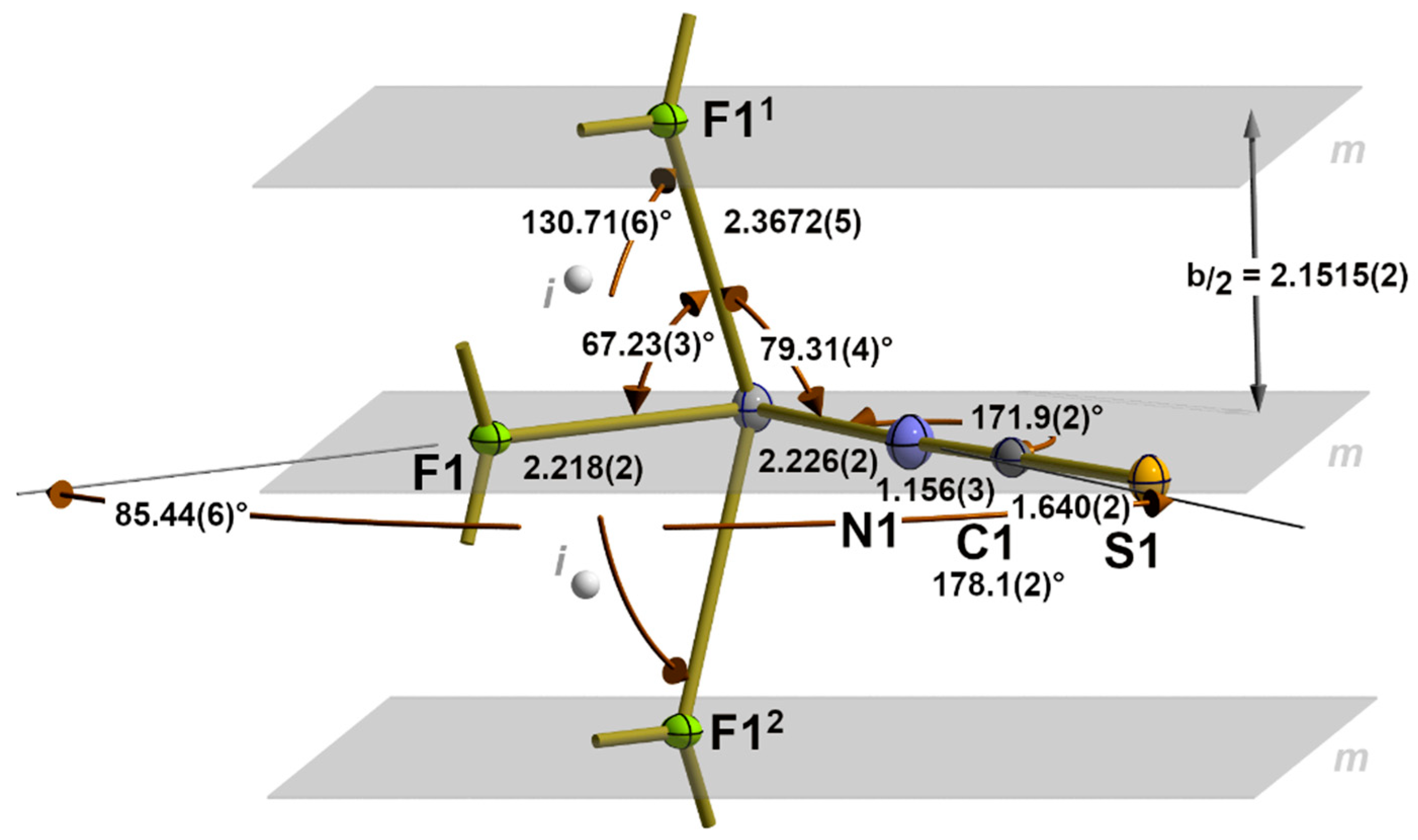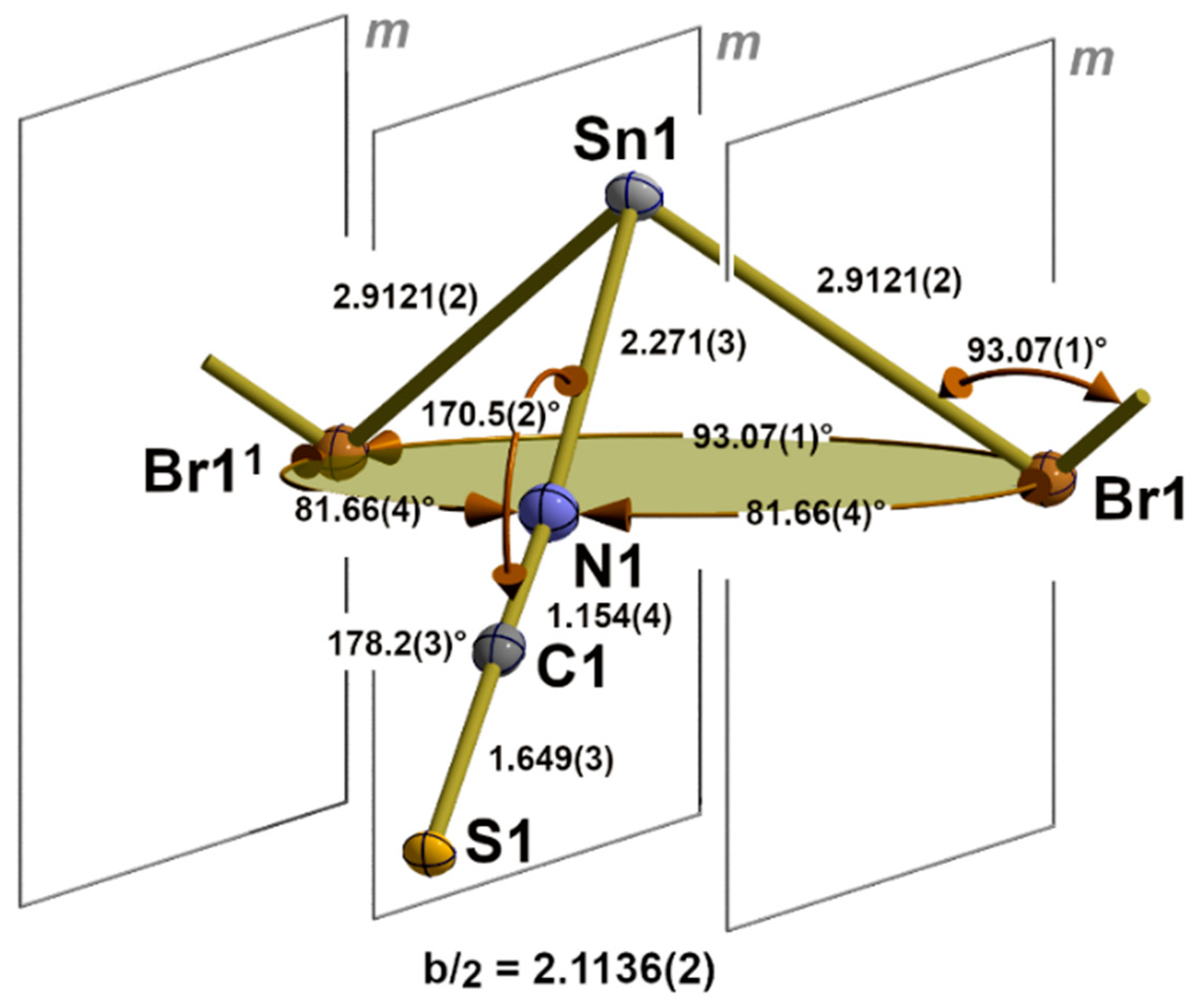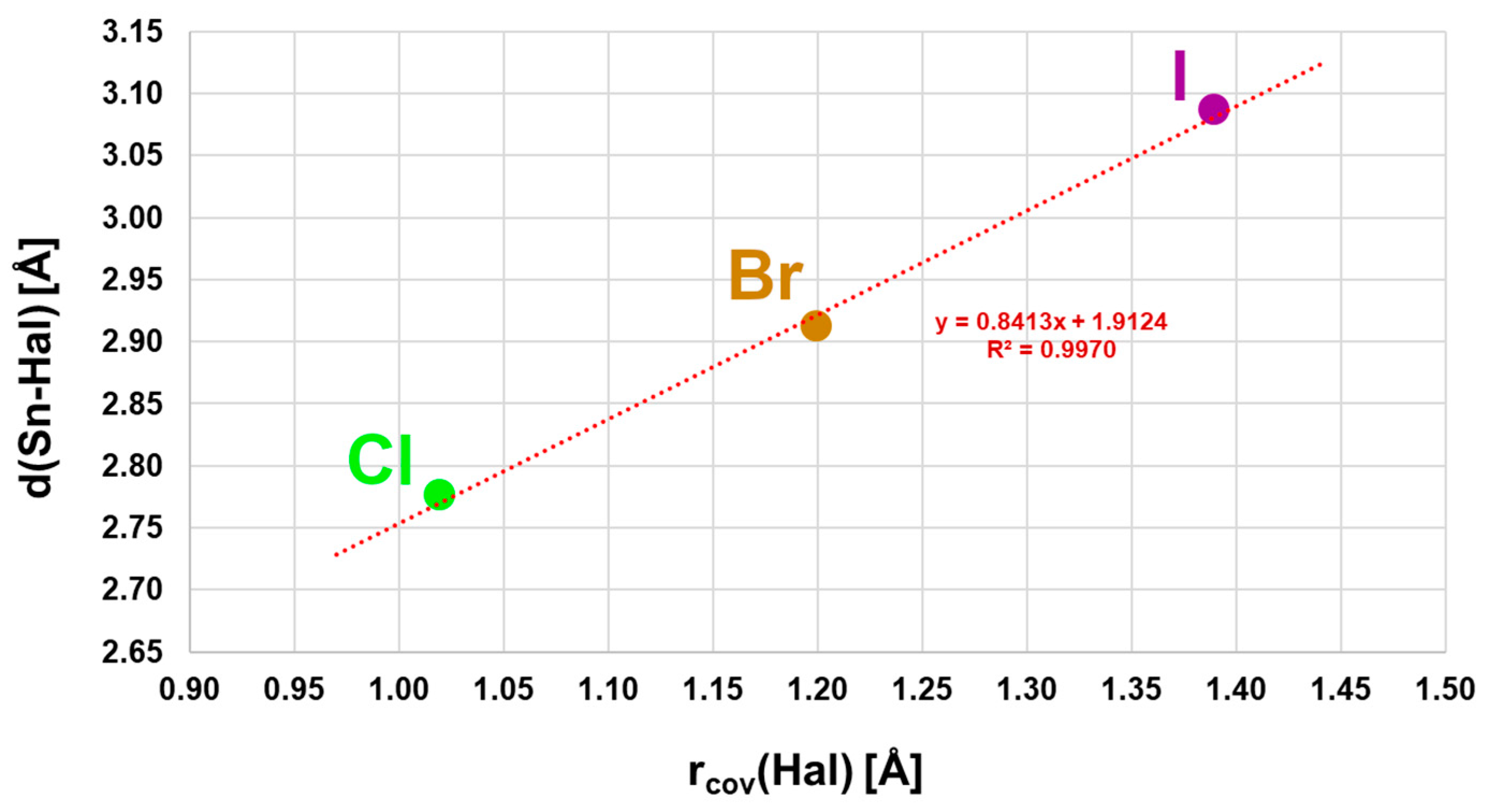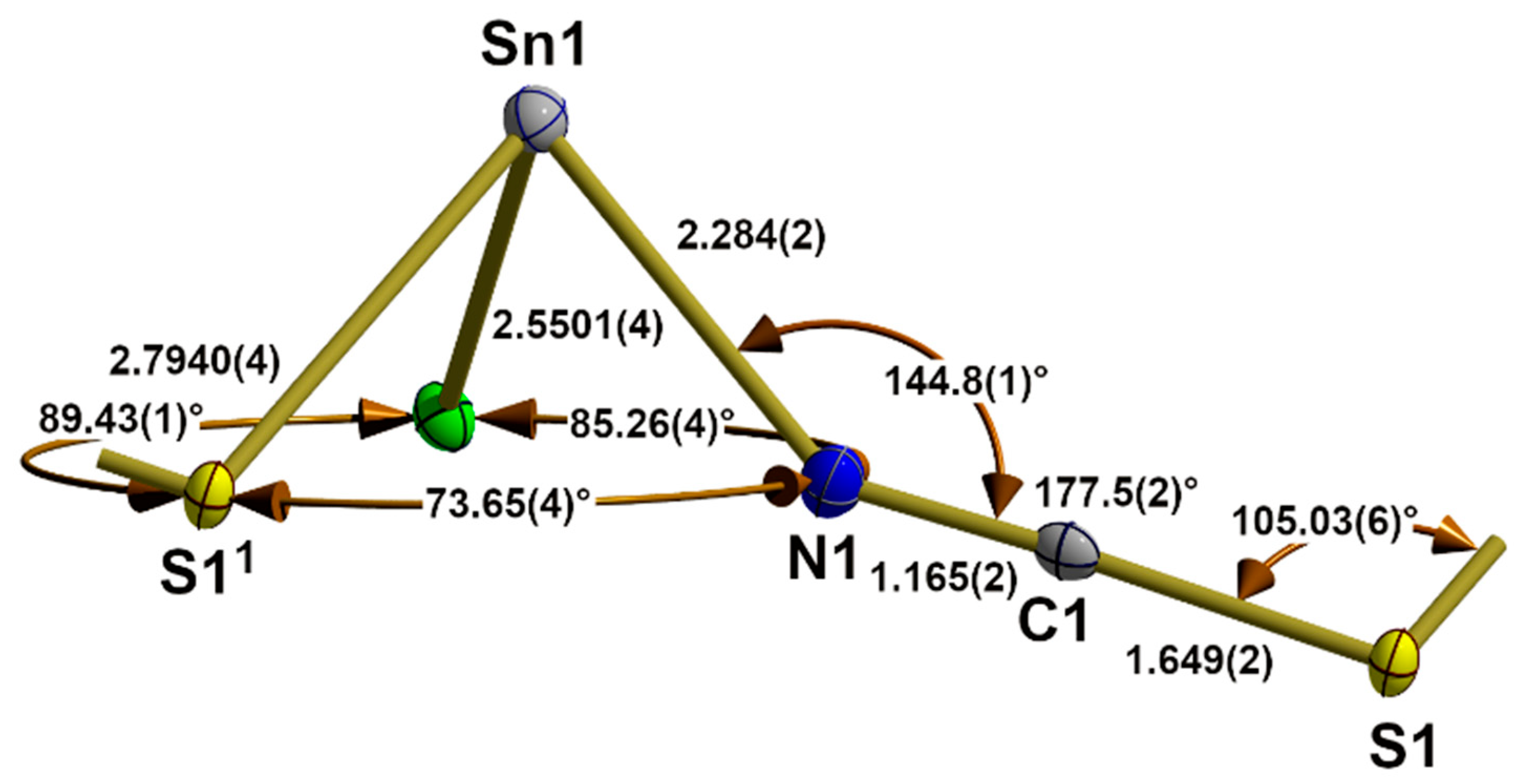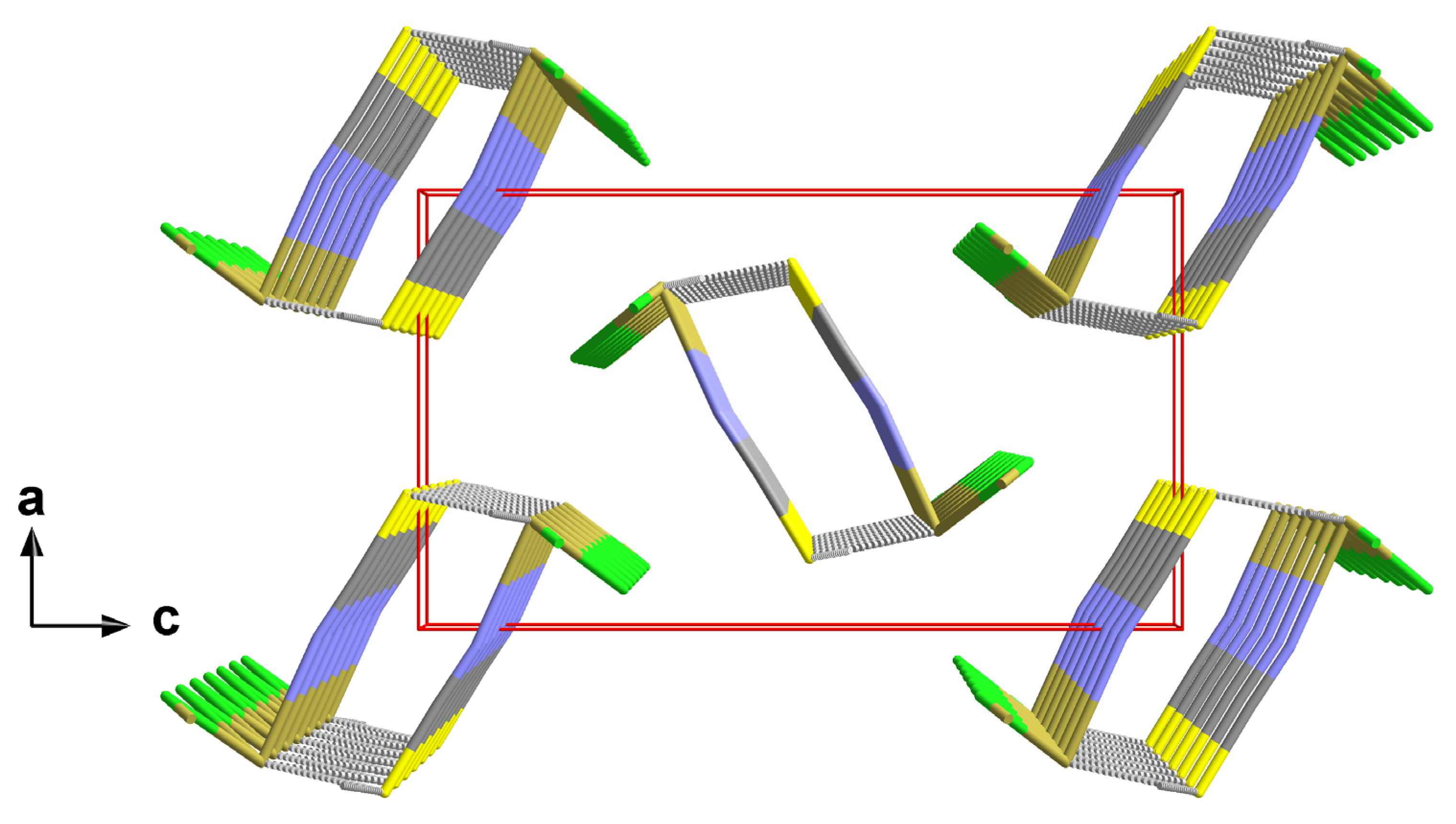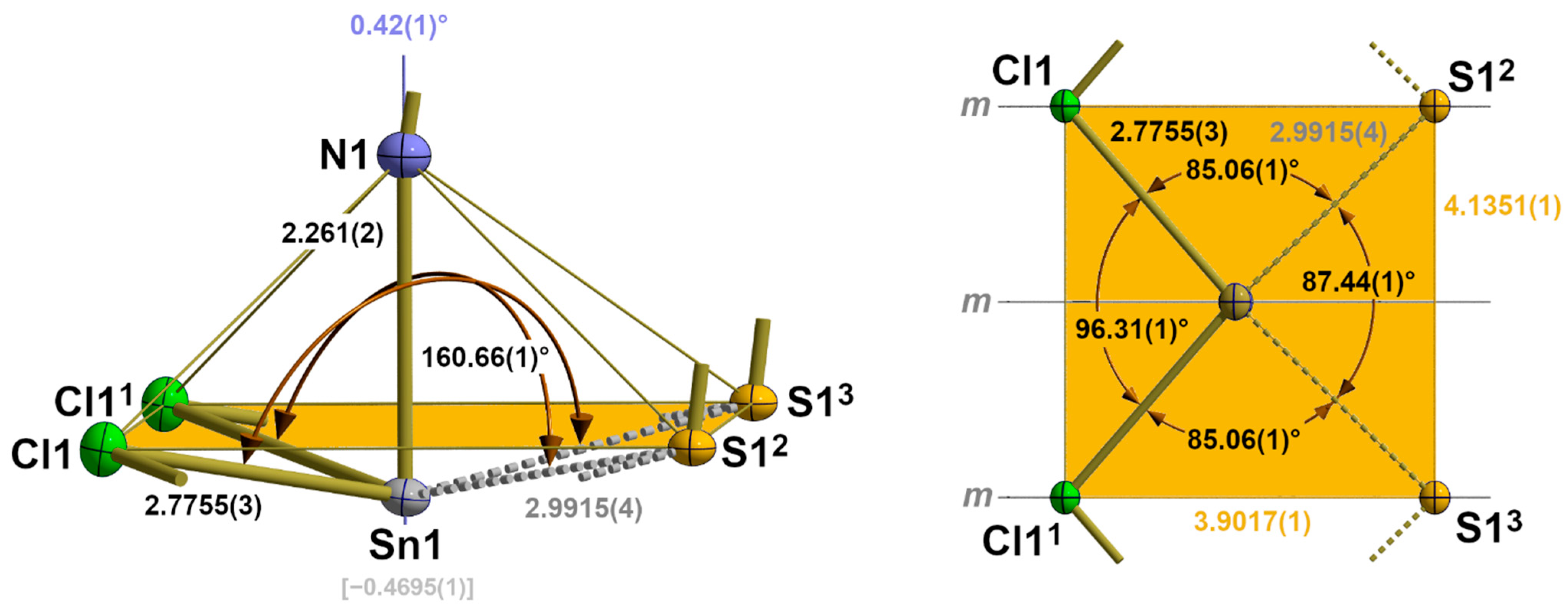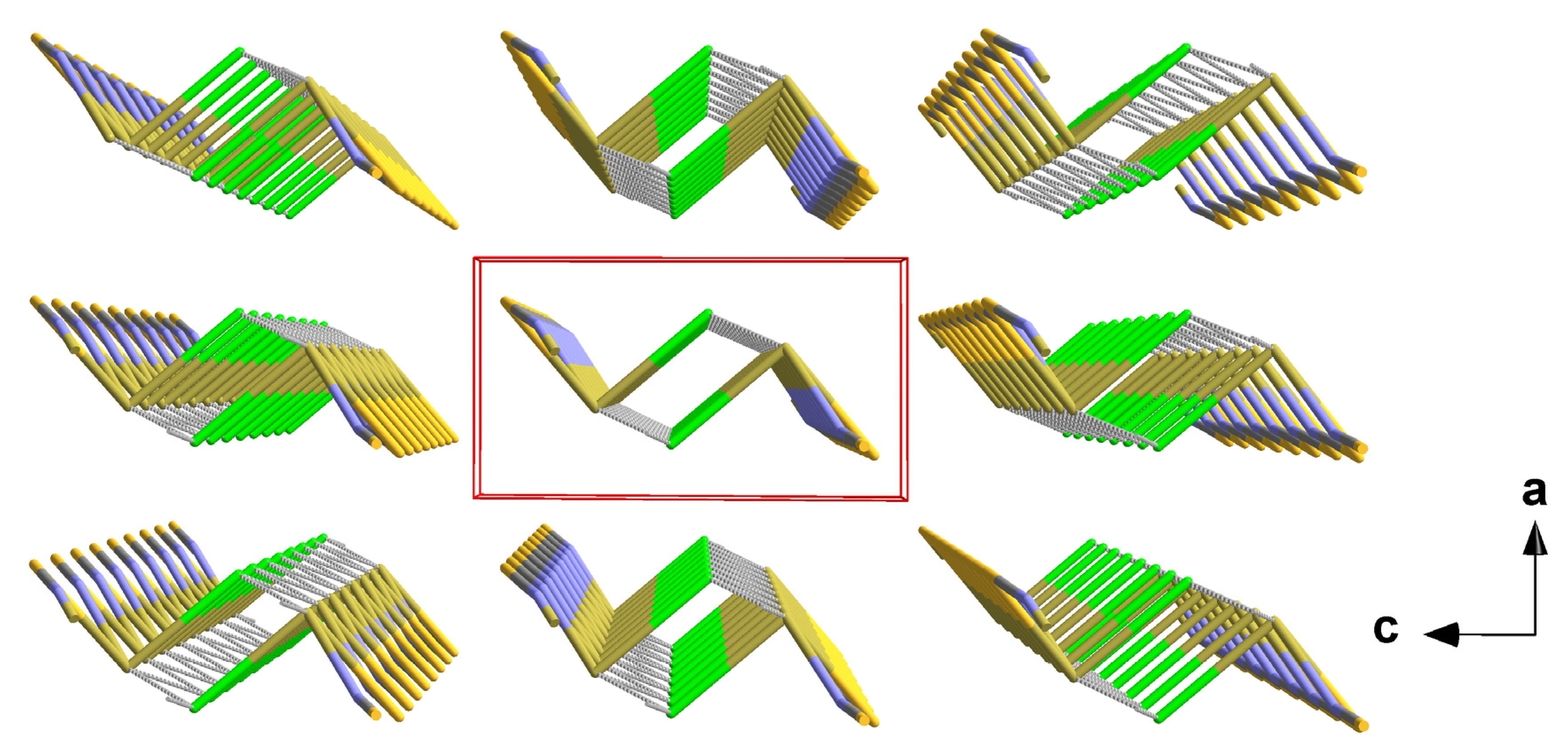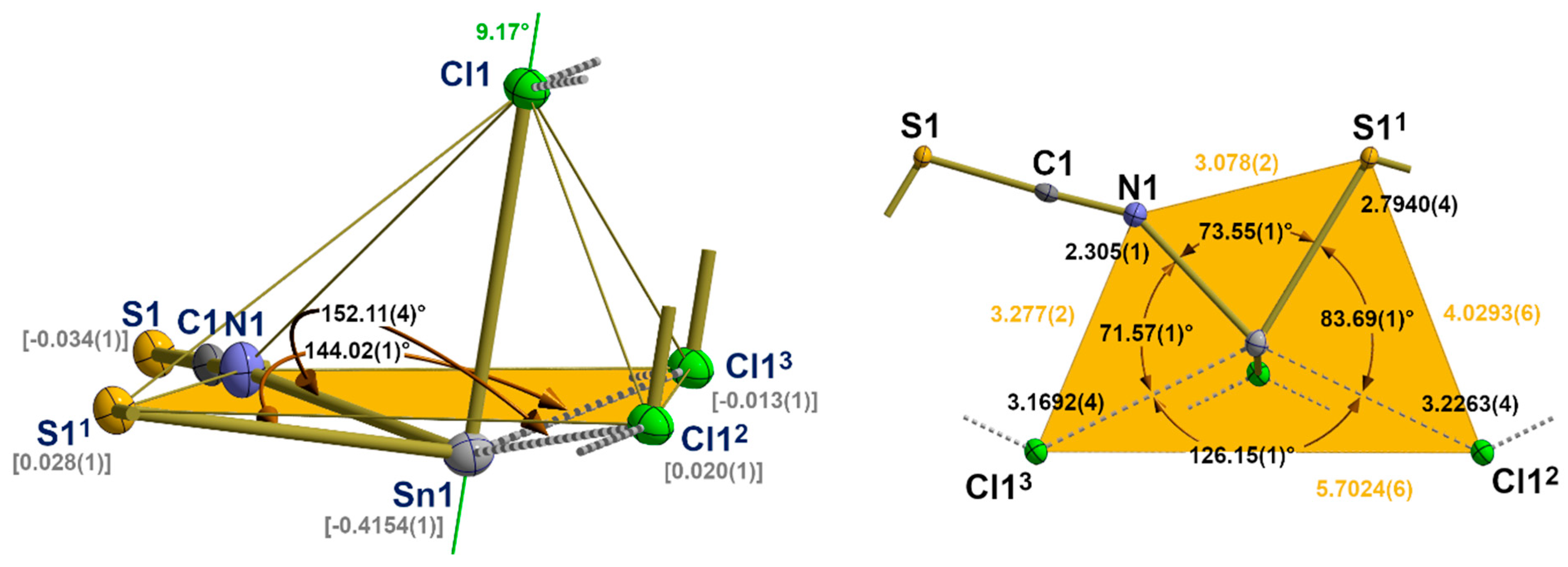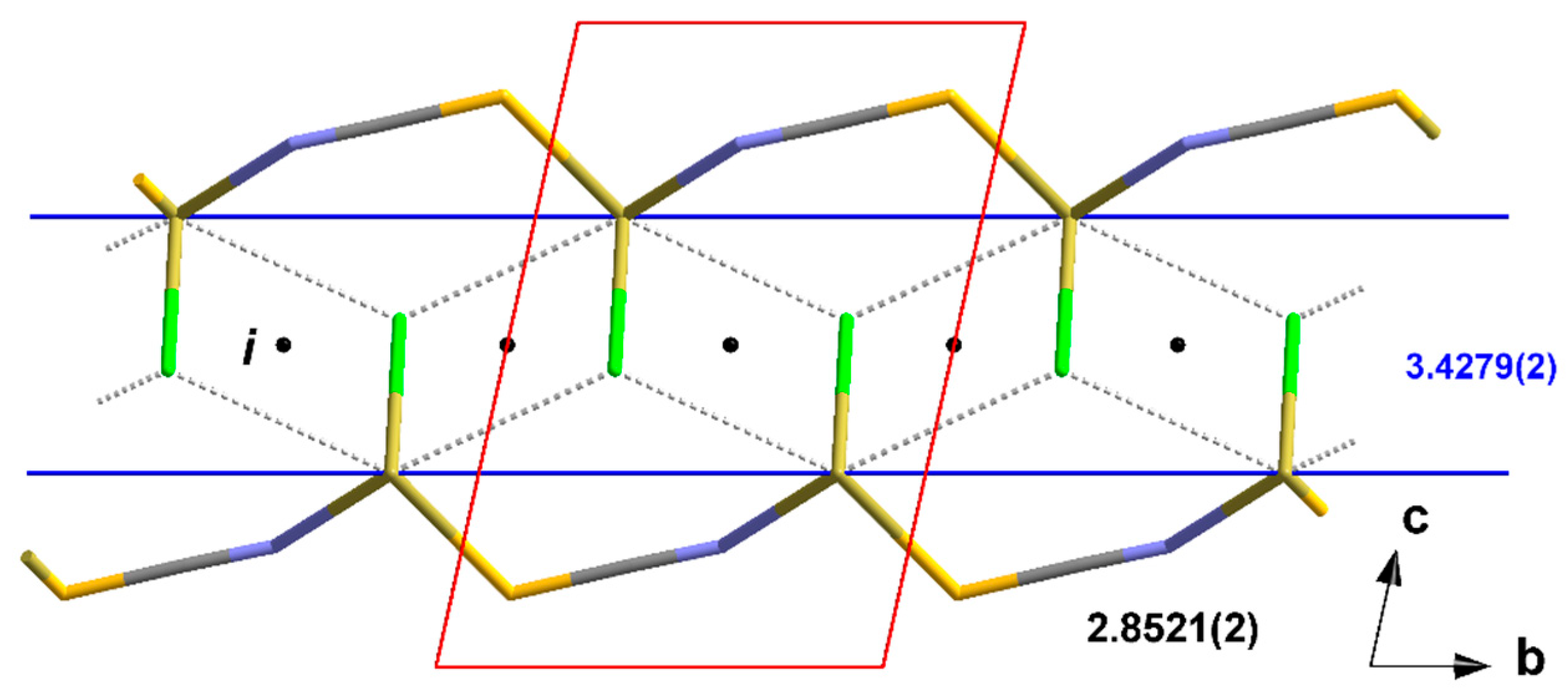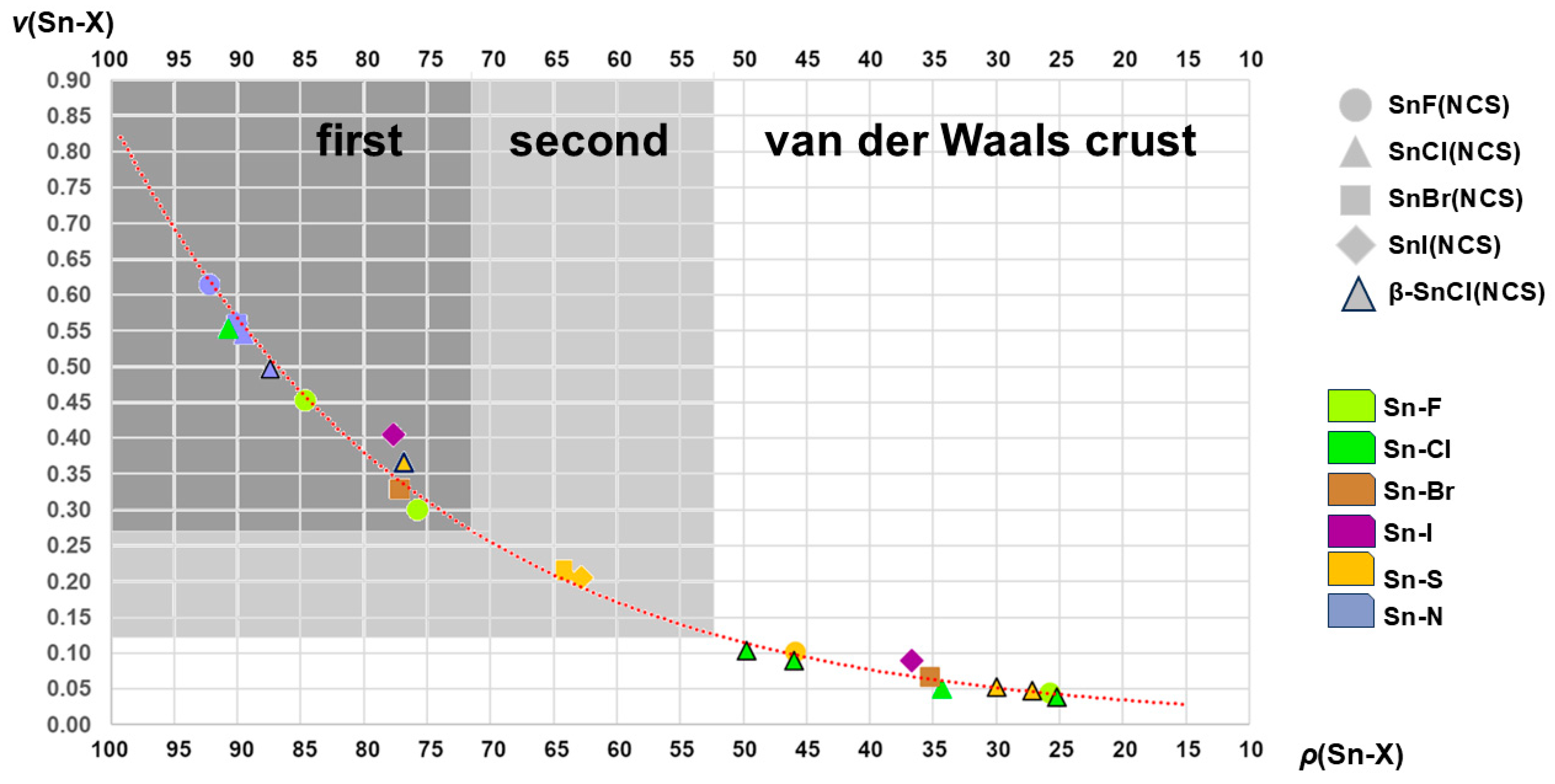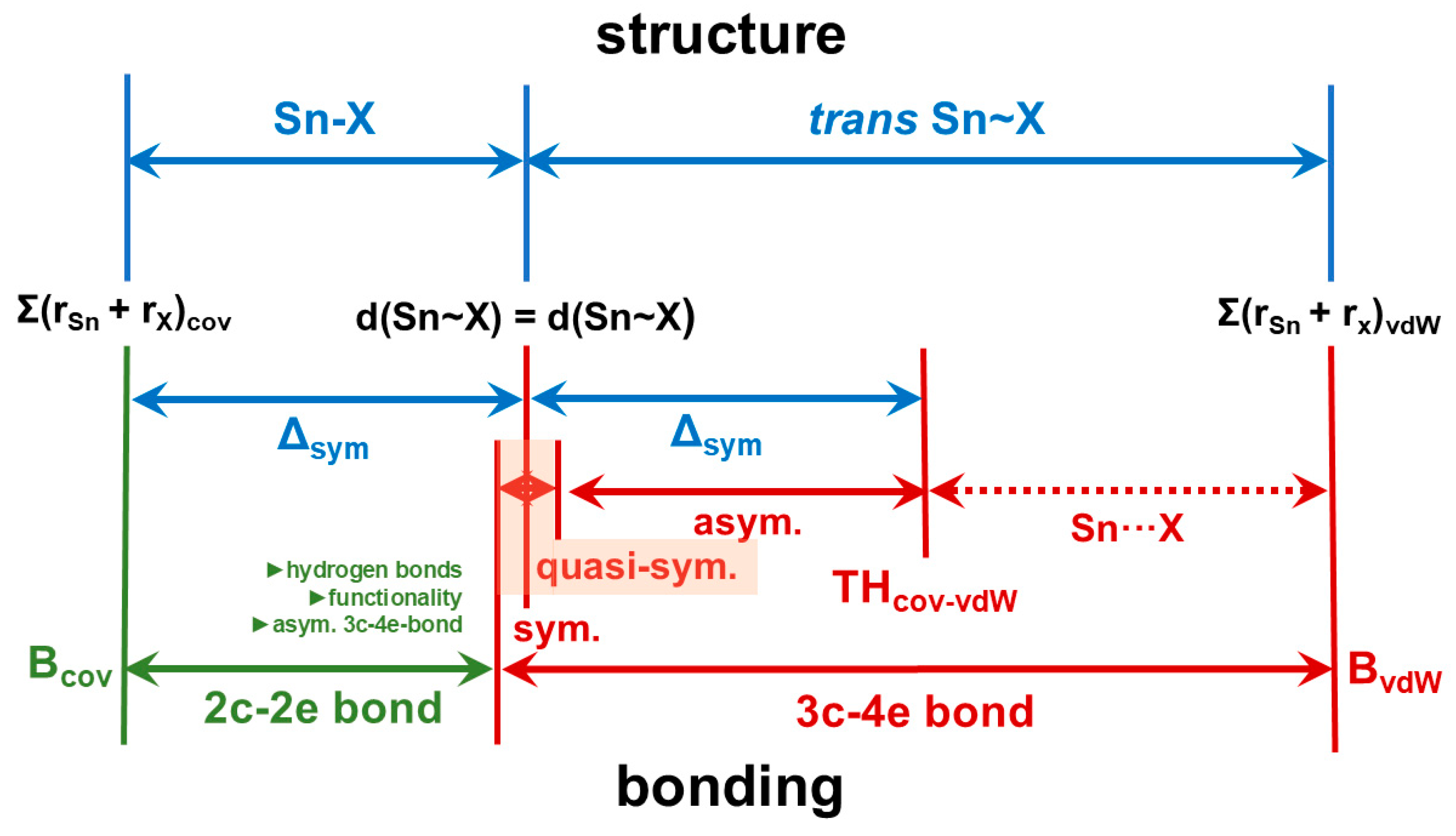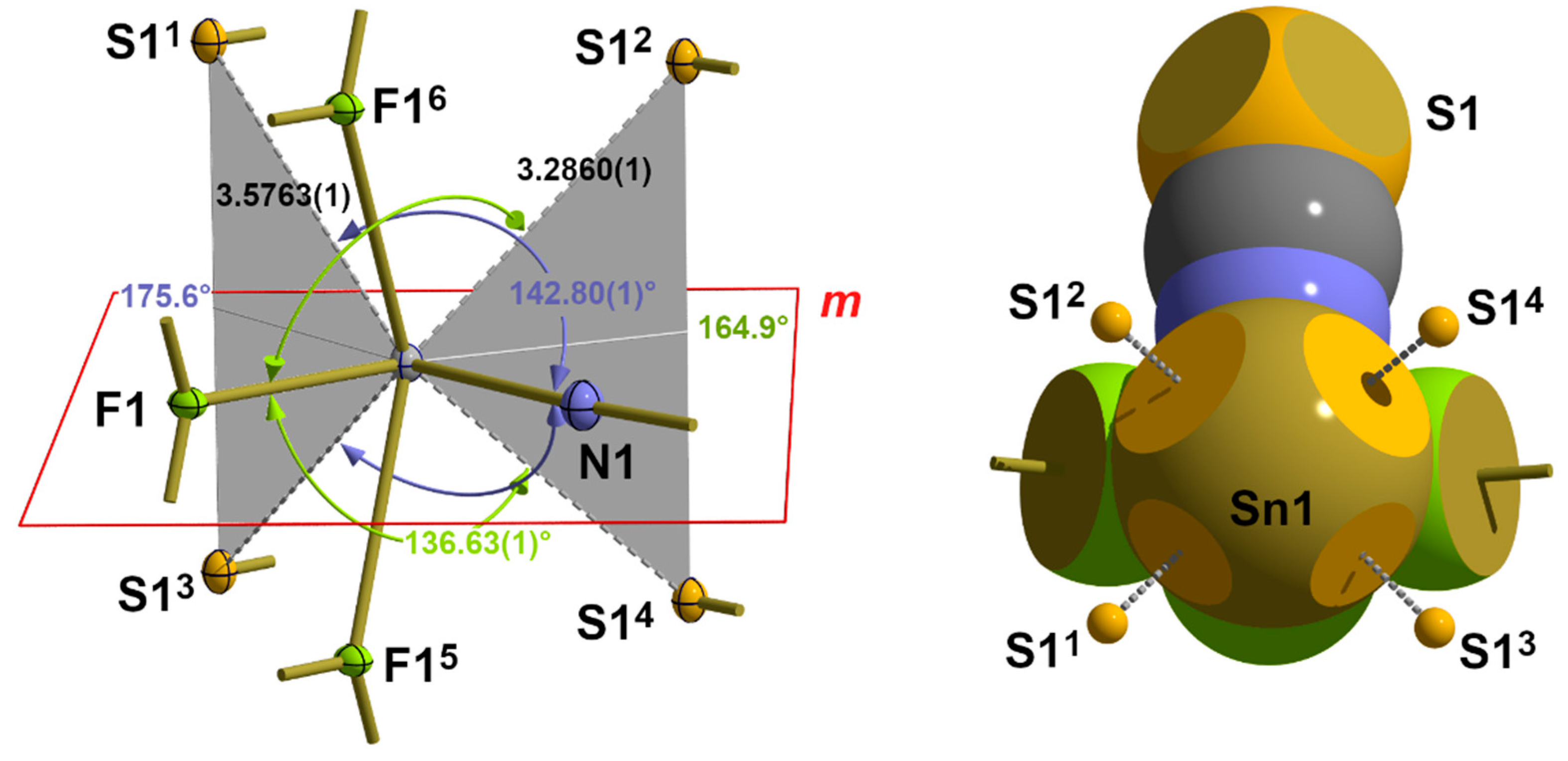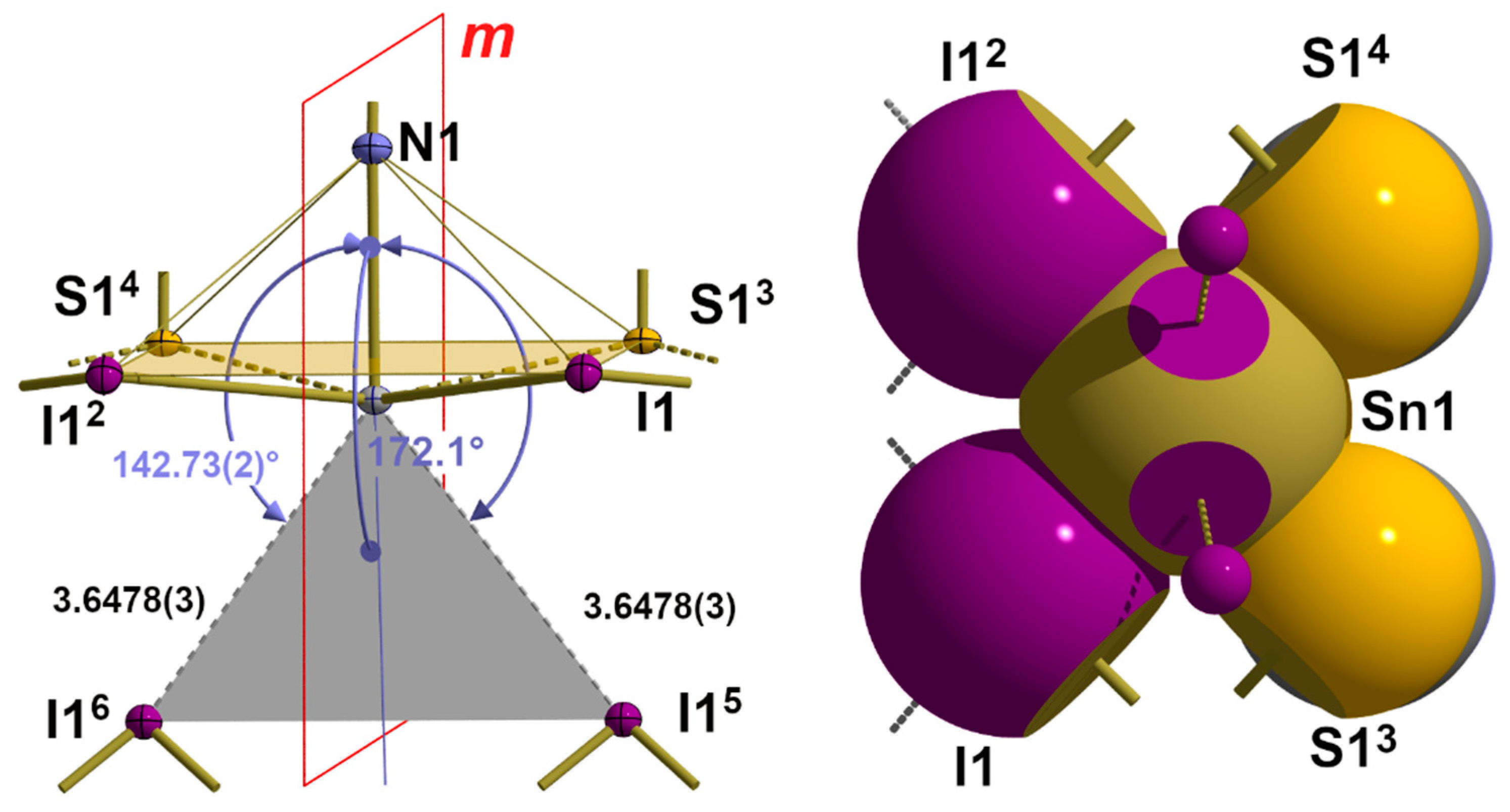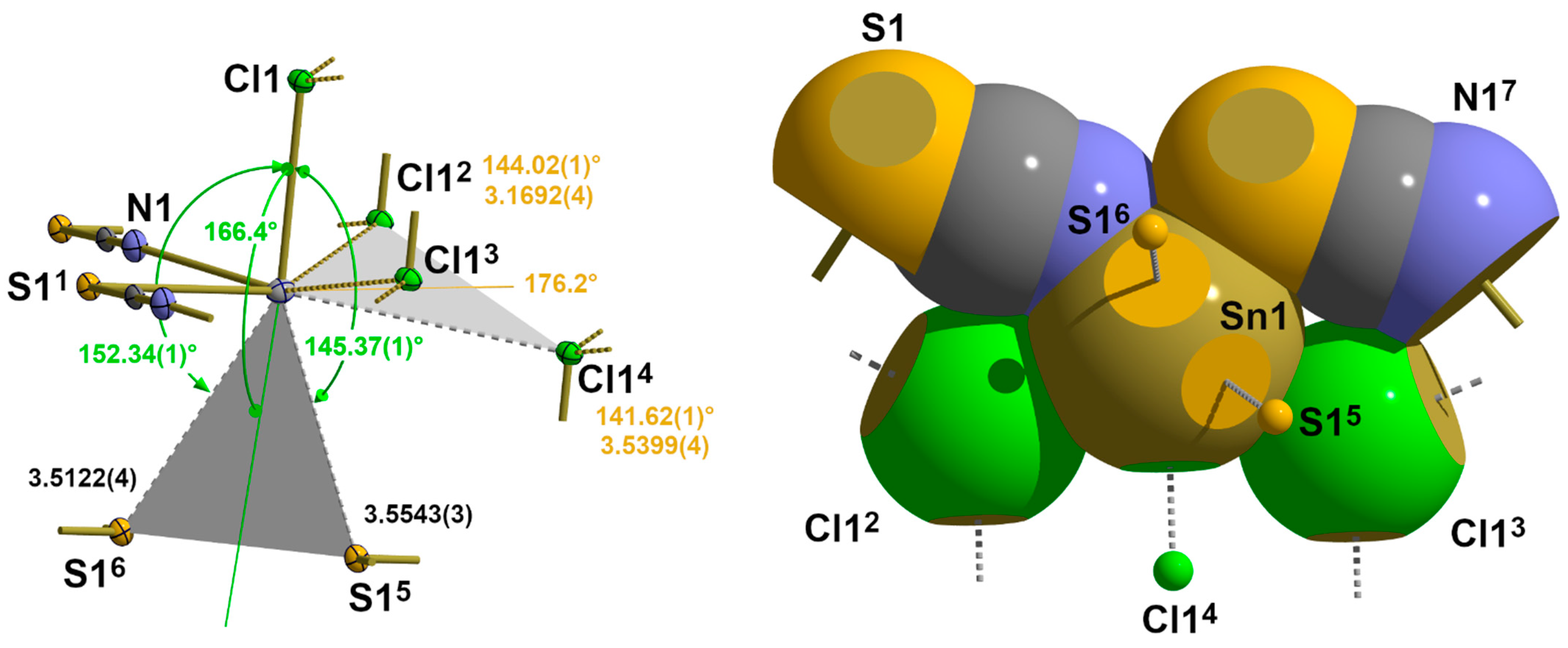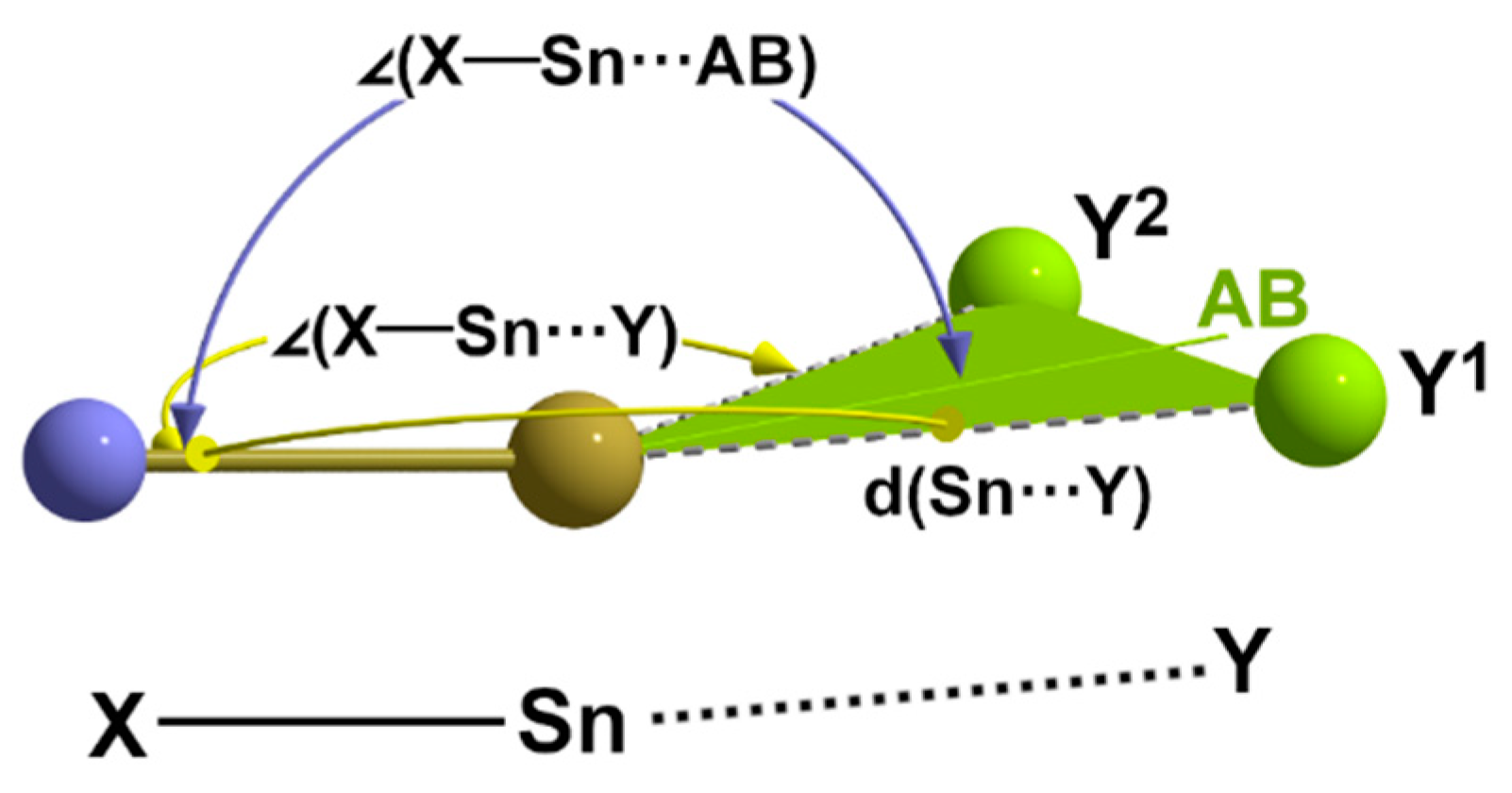Figure 1.
First seesaw 31-s coordination sphere of the tin atom in 1 with atom labelling and main bond lengths [Å], angles, and symmetry elements (m = mirror plane depicted in grey; i = centre of symmetry depicted as grey sphere). Symmetry transformations used to generate equivalent atoms: (1) −x, 1/2 + y, 1 − z; (2) −x, −1/2 + y, 1 − z.
Figure 1.
First seesaw 31-s coordination sphere of the tin atom in 1 with atom labelling and main bond lengths [Å], angles, and symmetry elements (m = mirror plane depicted in grey; i = centre of symmetry depicted as grey sphere). Symmetry transformations used to generate equivalent atoms: (1) −x, 1/2 + y, 1 − z; (2) −x, −1/2 + y, 1 − z.
Figure 2.
Ball-and-stick model (left) of the almost trigonal–planar coordinated fluorine atom in 1 with the bond lengths [Å], angles, and distance [Å] of the fluorine atom above the basal plane in square brackets (green); stick model (right) of the “ladder”-like arrangement of the tin and fluorine atoms in 1 with distances [Å] between “rails” and “rungs” and the position of crystallographic mirror planes m and inversion centres i; symmetry transformations used to generate equivalent atoms: (1) x, −1 + y, z; (2) −x, −1/2 + y, 1 − z.
Figure 2.
Ball-and-stick model (left) of the almost trigonal–planar coordinated fluorine atom in 1 with the bond lengths [Å], angles, and distance [Å] of the fluorine atom above the basal plane in square brackets (green); stick model (right) of the “ladder”-like arrangement of the tin and fluorine atoms in 1 with distances [Å] between “rails” and “rungs” and the position of crystallographic mirror planes m and inversion centres i; symmetry transformations used to generate equivalent atoms: (1) x, −1 + y, z; (2) −x, −1/2 + y, 1 − z.
Figure 3.
Details of the one-dimensional coordination polymer in the crystal structure of 3 showing the first, tpy “SnBr2/2(NCS)” coordination sphere (base of the pyramid in green) of the tin atom and position of the crystallographic mirror planes, m; selected bond lengths [Å] and angles; symmetry transformations used to generate equivalent atoms: (1) x, y + 1, z.
Figure 3.
Details of the one-dimensional coordination polymer in the crystal structure of 3 showing the first, tpy “SnBr2/2(NCS)” coordination sphere (base of the pyramid in green) of the tin atom and position of the crystallographic mirror planes, m; selected bond lengths [Å] and angles; symmetry transformations used to generate equivalent atoms: (1) x, y + 1, z.
Figure 4.
Correlation of the tin–halogen distances with the covalent radii of the halogen atoms in the α-SnCl(NCS) structure type.
Figure 4.
Correlation of the tin–halogen distances with the covalent radii of the halogen atoms in the α-SnCl(NCS) structure type.
Figure 5.
Asymmetric unit in the crystal structure of β-SnCl(NCS) with bond lengths [Å] and angles. Symmetry transformations used to generate equivalent atoms: (1) x, y − 1, z.
Figure 5.
Asymmetric unit in the crystal structure of β-SnCl(NCS) with bond lengths [Å] and angles. Symmetry transformations used to generate equivalent atoms: (1) x, y − 1, z.
Figure 6.
Perspective view of the crystal packing of 1 looking down the b-axis; stick model with unit cell presented in red.
Figure 6.
Perspective view of the crystal packing of 1 looking down the b-axis; stick model with unit cell presented in red.
Figure 7.
Perspective view of the crystal packing of 2; stick model with unit cell presented in red looking down the b-axis; interchain tin–sulphur contacts between neighbouring chains are indicated by dashed sticks in grey.
Figure 7.
Perspective view of the crystal packing of 2; stick model with unit cell presented in red looking down the b-axis; interchain tin–sulphur contacts between neighbouring chains are indicated by dashed sticks in grey.
Figure 8.
Side view (left) and top view (right) of the second coordination sphere of the tin atom in 2 with representative bond lengths [Å] and angles; distance (square brackets) of the tin atom below the basal plane (orange) of the quadrilateral pyramid; angle (blue value) between the tin–nitrogen bond and the normal vector of the basal plane. Symmetry transformations used to generate equivalent atoms: (1) x, 1 + y, z; (2) 1 − x, ½ + y, 1 − z; (3) 1 − x, −½ + y, 1 − z.
Figure 8.
Side view (left) and top view (right) of the second coordination sphere of the tin atom in 2 with representative bond lengths [Å] and angles; distance (square brackets) of the tin atom below the basal plane (orange) of the quadrilateral pyramid; angle (blue value) between the tin–nitrogen bond and the normal vector of the basal plane. Symmetry transformations used to generate equivalent atoms: (1) x, 1 + y, z; (2) 1 − x, ½ + y, 1 − z; (3) 1 − x, −½ + y, 1 − z.
Figure 9.
Overlay (left) of the second coordination spheres in 2–4 looking at the centres of the basal planes as a common focus; the bonds of first and second coordination spheres are drawn in the colours of the halogen atoms; graphical representation (right) of the ΔSn dependency on the van der Waals radius of the halogen atom with results of the linear regression analysis (red).
Figure 9.
Overlay (left) of the second coordination spheres in 2–4 looking at the centres of the basal planes as a common focus; the bonds of first and second coordination spheres are drawn in the colours of the halogen atoms; graphical representation (right) of the ΔSn dependency on the van der Waals radius of the halogen atom with results of the linear regression analysis (red).
Figure 10.
Ball-and-stick model (left) of the sulphur coordination in 2 with atom distances [Å] and angles; stick model (right) of the “zipper”-like arrangement of the primary building units as a result of the interchain tin–sulphur interactions with distances [Å] and positions of the symmetry elements (m = mirror plane, i = centre of symmetry); unit cell (red)); symmetry elements for the transformation of equivalent atoms: x, −1 + y, z.
Figure 10.
Ball-and-stick model (left) of the sulphur coordination in 2 with atom distances [Å] and angles; stick model (right) of the “zipper”-like arrangement of the primary building units as a result of the interchain tin–sulphur interactions with distances [Å] and positions of the symmetry elements (m = mirror plane, i = centre of symmetry); unit cell (red)); symmetry elements for the transformation of equivalent atoms: x, −1 + y, z.
Figure 11.
Perspective view of the crystal packing of 5; stick model with unit cell presented in red looking down the b-axis. The interchain tin–sulphur contacts between neighbouring chains are indicated by dashed sticks in grey.
Figure 11.
Perspective view of the crystal packing of 5; stick model with unit cell presented in red looking down the b-axis. The interchain tin–sulphur contacts between neighbouring chains are indicated by dashed sticks in grey.
Figure 12.
Ball-and-stick model of the second coordination sphere of the tin atom in 5 with representative atom distances [Å] and angles; distance (square brackets) of the tin atom below the least-squares plane of the basal atoms (orange) of the quadrilateral pyramid and the angle (green value) between the tin chlorine bond and the normal vector of the basal least-square plane. Symmetry transformations used to generate equivalent atoms: (1) x, −1 + y, z; (2) 1 − x, −y, 1 − z; (3) 1 − x, 1 − y, 1 − z.
Figure 12.
Ball-and-stick model of the second coordination sphere of the tin atom in 5 with representative atom distances [Å] and angles; distance (square brackets) of the tin atom below the least-squares plane of the basal atoms (orange) of the quadrilateral pyramid and the angle (green value) between the tin chlorine bond and the normal vector of the basal least-square plane. Symmetry transformations used to generate equivalent atoms: (1) x, −1 + y, z; (2) 1 − x, −y, 1 − z; (3) 1 − x, 1 − y, 1 − z.
Figure 13.
Stick model of the “zipper”-like arrangement of the atoms in 5 as a result of the interchain tin–chlorine interactions with characteristic distances [Å] between side parts and chain links; i = centres of symmetry; unit cell presented in red; symmetry elements for the transformation of equivalent atoms: (1) x, −1 + y, z.
Figure 13.
Stick model of the “zipper”-like arrangement of the atoms in 5 as a result of the interchain tin–chlorine interactions with characteristic distances [Å] between side parts and chain links; i = centres of symmetry; unit cell presented in red; symmetry elements for the transformation of equivalent atoms: (1) x, −1 + y, z.
Figure 14.
Graphical representation of the relationships between the interpenetration indices ρ and bond valences v for the complete list of interatomic distances Sn-X found in 1–5; areas of atom distances that were found in this work in the first, second, and van der Waals crust coordination spheres are marked as dark grey, grey, and white fields; the dotted curved line in red shows the course of the exponential trend line expressed by the formula v = 0.0156 e 0.0399ρ and the reliability index R2 = 0.9919.
Figure 14.
Graphical representation of the relationships between the interpenetration indices ρ and bond valences v for the complete list of interatomic distances Sn-X found in 1–5; areas of atom distances that were found in this work in the first, second, and van der Waals crust coordination spheres are marked as dark grey, grey, and white fields; the dotted curved line in red shows the course of the exponential trend line expressed by the formula v = 0.0156 e 0.0399ρ and the reliability index R2 = 0.9919.
Figure 15.
Structure–bonding relationships for the classification of strong/weak, covalent/non-covalent interactions in tin(II) compounds in terms of classical 2c-2e and various forms of 3c-4e bonds (sym = symmetrical [Q = 1], quasi-sym. = quasi-symmetrical [Q < 1.05], asym. = asymmetrical [1.05 < Q < 1.5]); factors that can influence the length of the 2c-2e bond are shown in dark green.
Figure 15.
Structure–bonding relationships for the classification of strong/weak, covalent/non-covalent interactions in tin(II) compounds in terms of classical 2c-2e and various forms of 3c-4e bonds (sym = symmetrical [Q = 1], quasi-sym. = quasi-symmetrical [Q < 1.05], asym. = asymmetrical [1.05 < Q < 1.5]); factors that can influence the length of the 2c-2e bond are shown in dark green.
Figure 16.
Ball-and-stick model (left) and space-filling model (right) with the position of the crystallographic mirror plane m and interatomic distances [Å] and angles (trans to F1 in green, trans to N1 in blue) describing the long-range Sn···S contacts in 1; bifurcated tetrel bonds are indicated by grey planes and ABs; symmetry transformations used to generate equivalent atoms: (1) 1/2 − x, 1 − y, −1/2 + z; (2) 1 − x, 1/2 + y, 1 − z; (3) 1/2 − x, −y, −1/2 + z; (4) 1 − x, −1/2 + x, −1 − z; (5) −x, −1/2 + y, 1 − z; (6) −x, 1/2 + y, 1 − z.
Figure 16.
Ball-and-stick model (left) and space-filling model (right) with the position of the crystallographic mirror plane m and interatomic distances [Å] and angles (trans to F1 in green, trans to N1 in blue) describing the long-range Sn···S contacts in 1; bifurcated tetrel bonds are indicated by grey planes and ABs; symmetry transformations used to generate equivalent atoms: (1) 1/2 − x, 1 − y, −1/2 + z; (2) 1 − x, 1/2 + y, 1 − z; (3) 1/2 − x, −y, −1/2 + z; (4) 1 − x, −1/2 + x, −1 − z; (5) −x, −1/2 + y, 1 − z; (6) −x, 1/2 + y, 1 − z.
Figure 17.
Ball-and-stick model (left) with the crystallographic mirror plane m and interatomic distances [Å] and angles of the long-range tin···iodine contacts as an example of these interactions in the α-SnCl(NCS) structure type; bifurcated tetrel bond indicated as a grey plane; angle bisector AB presented in blue; space-filling model (right) visualizing these contacts on the back of the tin–nitrogen bond; symmetry trans-formations used to generate equivalent atoms: (2) x, 1 + y, z; (3) 1−x, −1/2 + y, 1−z; (4) 1−x, 1/2 + y, 1−z; (5) 1/2 + x, 1/2−y, 1/2−z; (6) 1/2 + x, 3/2 + y, 1/2−z.
Figure 17.
Ball-and-stick model (left) with the crystallographic mirror plane m and interatomic distances [Å] and angles of the long-range tin···iodine contacts as an example of these interactions in the α-SnCl(NCS) structure type; bifurcated tetrel bond indicated as a grey plane; angle bisector AB presented in blue; space-filling model (right) visualizing these contacts on the back of the tin–nitrogen bond; symmetry trans-formations used to generate equivalent atoms: (2) x, 1 + y, z; (3) 1−x, −1/2 + y, 1−z; (4) 1−x, 1/2 + y, 1−z; (5) 1/2 + x, 1/2−y, 1/2−z; (6) 1/2 + x, 3/2 + y, 1/2−z.
Figure 18.
Ball-and-stick model (left) with atom distances [Å] and angles and space-filling model (right, viewing direction along the apical Sn-Cl bond) visualizing the geometrical details of the four long-range contacts in 5; contacts trans to the nitrogen atom labelled in green, those trans to the sulphur atom in orange, and bifurcated tetrel bonds indicated as grey planes; symmetry operation used to generate symmetry related atoms: (1) x, y−1, z; (2) −x + 1, −y + 1, −z + 1; (3) −x + 1, −z, −z + 1; (4) x−1, y, z; (5) x−1, y−1, z; (6) −x + 1, −y + 1, −z + 2; (7) x, −1 + y, z.
Figure 18.
Ball-and-stick model (left) with atom distances [Å] and angles and space-filling model (right, viewing direction along the apical Sn-Cl bond) visualizing the geometrical details of the four long-range contacts in 5; contacts trans to the nitrogen atom labelled in green, those trans to the sulphur atom in orange, and bifurcated tetrel bonds indicated as grey planes; symmetry operation used to generate symmetry related atoms: (1) x, y−1, z; (2) −x + 1, −y + 1, −z + 1; (3) −x + 1, −z, −z + 1; (4) x−1, y, z; (5) x−1, y−1, z; (6) −x + 1, −y + 1, −z + 2; (7) x, −1 + y, z.
Figure 19.
Schematic representation of the main structural parameters defining a bifurcated tetrel bond to two donor atoms Y1 and Y2; AB = angle bisector.
Figure 19.
Schematic representation of the main structural parameters defining a bifurcated tetrel bond to two donor atoms Y1 and Y2; AB = angle bisector.
Table 1.
Crystal data, data collection, structure refinement, and CSD numbers of 1–5. Data of isostructural compounds are marked with a coloured background.
Table 1.
Crystal data, data collection, structure refinement, and CSD numbers of 1–5. Data of isostructural compounds are marked with a coloured background.
| | SnF(NCS) | α-SnCl(NCS) | SnBr(NCS) | SnI(NCS) | β-SnCl(NCS) |
|---|
| | 1 | 2 | 3 | 4 | 5 |
|---|
| Temperature | 100(2) |
| Wavelength [Å] | 0.71073 |
| 2θmax | 60° |
| Empirical formula | C F N S Sn | C Cl N S Sn | C Br N S Sn | C I N S Sn | C Cl N S Sn |
| Formula weight | 195.77 | 212.22 | 256.68 | 303.67 | 212.22 |
| Crystal system | orthorhombic | orthorhombic | triclinic |
| Space group | Pnma | Pnma | P |
| Unit cell dimensions | | | | | |
| a [Å] | 7.5937(3) | 7.6567(2) | 7.7230(3) | 7.9583(3) | 4.5920(2) |
| b [Å] | 4.3031(2) | 4.1351(1) | 4.2273(2) | 4.3450(1) | 5.7024(2) |
| c [Å] | 11.9462(5) | 13.2907(4) | 13.6146(5) | 14.1490(5) | 8.4084(4) |
| α | 90° | 90° | 90° | 90° | 77.502(2)° |
| β | 90° | 90° | 90° | 90° | 89.191(2)° |
| γ | 90° | 90° | 90° | 90° | 87.101(2)° |
| V [Å3] | 390.36(3) | 420.80(2) | 444.48(3) | 489.26(3) | 214.68(2) |
| Z, Z′ | 4, ½ | 4, ½ | 1, ½ |
| dcalc [g/cm3] | 3.331 | 3.350 | 3.836 | 4.123 | 3.283 |
| μ(MoKα) [mm−1] | 6.891 | 6.988 | 15.005 | 11.776 | 6.848 |
| F(000) | 352 | 384 | 456 | 528 | 192 |
| Reflections collected | 23,696 | 56,867 | 55,406 | 55,420 | 9562 |
| Reflections unique, Rint | 637, 0.0465 | 694, 0.0544 | 722, 0.0374 | 798, 0.0527 | 1253, 0.0286 |
| Data/restraints/parameters | 637/0/32 | 694/0/32 | 722/0/32 | 798/0/31 | 1253/0/47 |
| Goodness-of-fit on F2 | 1.123 | 1.129 | 1.175 | 1.264 | 1.103 |
| R1, wR2 [I > 2σ(I)] | 0.0116, 0.0237 | 0.0101, 0.0254 | 0.0119, 0.0316 | 0.0151, 0.0379 | 0.0115, 0.0232 |
| R1, wR2 [all data] | 0.0136, 0.0242 | 0.0120, 0.0261 | 0.0120, 0.0316 | 0.0164, 0.0382 | 0.0122, 0.0234 |
| Extinction coefficient | 0.0025(3) | n/a | n/a | n/a | 0.0222(8) |
| ±Δe [eÅ−3] | 0.331/−0.401 | 0.291/−0.570 | 0.571/−0.6.16 | 1.002/−1.174 | 0.446/−0.438 |
| CSD numbers | 2449526 | 2449528 | 2449529 | 2449530 | 2449531 |
Table 2.
Bond lengths and angles in the first 30-coordination sphere of 2 (Hal = Cl), 3 (Hal = Br), and 4 (Hal = I); ΔSn = distance of the tin atom from the basal plane of the trigonal pyramid.
Table 2.
Bond lengths and angles in the first 30-coordination sphere of 2 (Hal = Cl), 3 (Hal = Br), and 4 (Hal = I); ΔSn = distance of the tin atom from the basal plane of the trigonal pyramid.
| Hal | d(Sn-Hal) [Å] | d(Sn-N) [Å] | ∠(Hal-Sn-Hal) | ∠(Hal-Sn-N) | ΔSn [Å] | ∠(Sn-Hal-Sn) ** |
| Cl | 2.7755(3) | 2.261(2) | 96.30(1)° | 80.53(3)° | 1.594(1) | 96.30(1)° |
| Br | 2.9122(2) | 2.271(3) | 93.07(4)° | 81.66(4)° | 1.652(1) | 93.07(1)° |
| I * | 3.0865(3) | 2.261(4) | 89.48(1)° | 84.10(7)° | 1.684(2) | 89.48(1)° |
Table 3.
Bond lengths and angles of the isothiocyanate ligands in 1–5.
Table 3.
Bond lengths and angles of the isothiocyanate ligands in 1–5.
| | Hal | μ | | d(N-C) [Å] | d(C-S) [Å] | ∠(Sn-N-C) | ∠(N-C-S) |
| 1 | F | 1 | N | 1.156(3) | 1.640(2) | 171.9(2)° | 178.1(2)° |
| 2 | Cl | 1 | N | 1.158(2) | 1.646(2) | 170.9(2)° | 177.7(2)° |
| 3 | Br | 1 | N | 1.154(4) | 1.649(3) | 170.5(2)° | 178.2(3)° |
| 4 | I | 1 | N | 1.155(5) | 1.652(4) | 170.8(3)° | 178.2(4)° |
| | mean | 1 | N | 1.156(2) | 1.649(3) | 170.7(2)° | 178.0(3)° |
| 5 | Cl | 2 | κ2NS | 1.165(2) | 1.649(2) | 144.8(1)° | 177.5(2)° |
Table 4.
Main interatomic distances [Å] and angles characterizing the second coordination spheres of the tin atoms in the α-SnCl(NCS) structure type.
Table 4.
Main interatomic distances [Å] and angles characterizing the second coordination spheres of the tin atoms in the α-SnCl(NCS) structure type.
| Hal | d(Sn-Hal) | d(Sn-S) | d(Sn-N) | ∠(Hal-Sn-S) | ΔSn | d(Hal···S) | b |
| Cl | 2.7755(3) | 2.9915(4) | 2.261(2) | 160.66(1)° | 0.4695(1) | 3.9017(1) | 4.1351(1) |
| Br | 2.9122(2) | 2.9880(5) | 2.271(3) | 162.51(2)° | 0.4466(1) | 4.0154(2) | 4.2273(2) |
| I | 3.0865(3) | 3.0093(7) | 2.261(4) | 165.60(2)° | 0.3799(6) | 4.3450(1) | 4.3450(1) |
Table 5.
Interatomic distances [Å] and angles of the sulphur atoms in 2–4 of the first and second coordination spheres of the tin atoms; ΔS = distance [Å] of the sulphur atoms from the basal plane.
Table 5.
Interatomic distances [Å] and angles of the sulphur atoms in 2–4 of the first and second coordination spheres of the tin atoms; ΔS = distance [Å] of the sulphur atoms from the basal plane.
| Hal | d(S···Sn) | d(S-C) | ∠(Sn···S···Sn) | ∠(C-S···Sn) | ΔS | d(Sn···Sn) = b |
| Cl | 2.9916(1) | 1.646(2) | 87.44(1)° | 104.20(2)° | 1.069(1) | 4.1351(1) |
| Br | 2.9880(1) | 1.649(3) | 90.04(1)° | 104.39(1)° | 1.051(2) | 4.2273(2) |
| I | 3.0093(7) | 1.652(4) | 92.43(3)° | 103.44(1)° | 1.058(3) | 4.3450(1) |
Table 6.
Interatomic distances [Å] characterizing the long-range contacts in the crystal structures of 1–5; CN = coordination number.
Table 6.
Interatomic distances [Å] characterizing the long-range contacts in the crystal structures of 1–5; CN = coordination number.
| | SnF(NCS) | α-SnCl(NCS) | SnBr(NCS) | SnI(NCS) | β-SnCl(NCS) |
| CNcov | 4 | 5 | 5 | 5 | 5 |
| d(Sn···Hal) | - | 3.4461(4) | 3.5038(3) | 3.6478(3) | 3.5399(4) |
| | - | 3.4461(4) | 3.5038(3) | 3.6478(3) | - |
| d(Sn···S) | 3.2860(1) | - | - | - | 3.5122(4) |
| | 3.2860(1) | - | - | - | 3.5543(3) |
| | 3.5763(1) | - | - | - | - |
| | 3.5763(1) | - | - | - | - |
| CN(cov + weak) | 8 | 7 | 7 | 7 | 8 |
Table 7.
Interatomic angles in the case of the weak Sn-Y (Y = Hal, S) interactions found in the crystal structures of 1–5; CN = coordination number.
Table 7.
Interatomic angles in the case of the weak Sn-Y (Y = Hal, S) interactions found in the crystal structures of 1–5; CN = coordination number.
| | SnF(NCS) | α-SnCl(NCS) | SnBr(NCS) | SnI(NCS) | β-SnCl(NCS) |
| CNcov | 4 | 5 | 5 | 5 | 5 |
| ∠(N-Sn···Hal) | - | 141.92(1)° | 142.12(1)° | 142.72(2)° | 141.62(4)° |
| | - | 141.92(1)° | 142.12(1)° | 142.72(2)° | - |
| ∠(Cl-Sn···S) | | - | - | - | 152.34(1)° |
| | | - | - | - | 145.37(1)° |
| ∠(F-Sn···S) | 136.63(1)° | - | - | - | - |
| | 136.63(1)° | - | - | - | - |
| ∠(N-Sn···S) | 142.80(1)° | - | - | - | - |
| | 142.80(1)° | - | - | - | - |
| CN(cov + weak) | 8 | 7 | 7 | 7 | 8 |
Table 8.
Interatomic distances [Å] and angles characterizing the bifurcated tetrel bonds in 2–4 as a function of the halogen atom; AB = angle bisector.
Table 8.
Interatomic distances [Å] and angles characterizing the bifurcated tetrel bonds in 2–4 as a function of the halogen atom; AB = angle bisector.
| Hal | d(Hal···Sn) | ∠(N-Sn···Hal) | ∠(N-Sn···AB) | ∠(Hal···Sn···Hal) | d(Hal···Hal) |
| Cl | 3.4461(4) | 141.92(1)° | 169.7° | 73.73(1)° | 4.1351(1) |
| Br | 3.5038(3) | 142.12(1)° | 171.7° | 74.20(1)° | 4.2273(2) |
| I | 3.6478(3) | 142.72(2)° | 172.1° | 73.10(1)° | 4.3450(1) |
Table 9.
Atom distances [Å] and angles within the square–pyramidal coordinated halogen atoms according to all their contacts within the van der Waals crust coordination spheres.
Table 9.
Atom distances [Å] and angles within the square–pyramidal coordinated halogen atoms according to all their contacts within the van der Waals crust coordination spheres.
| Hal | d(Hal···Sn) | d(Hal-Sn) | ∠(Sn···Hal···Sn) | ∠(Sn-Hal···Sn) | ΔHal | d(Sn···Sn) = b |
| Cl | 3.4460(4) | 2.7756(3) | 73.74(1)° | 88.61(1)° | 0.7130(4) | 4.1351(1) |
| Br | 3.5037(3) | 2.9122(2) | 74.21(1)° | 89.18(1)° | 0.7867(3) | 4.2230(2) |
| I | 3.6478(3) | 3.0865(3) | 73.10(1)° | 90.11(1)° | 0.9066(3) | 4.3450(1) |
